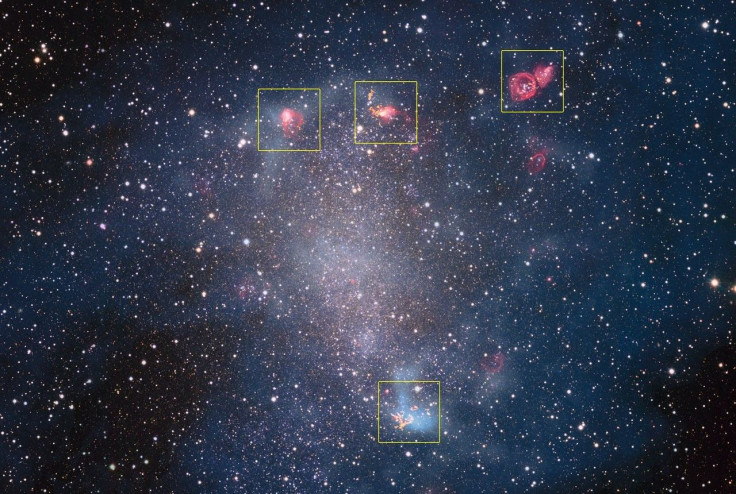NGC 6822: Dwarf Galaxy's Star-Forming Regions Revealed In New ESO Images

A team of astronomers using the European Southern Observatory’s Atacama Large Millimeter/submillimeter Array (ALMA) and the 2.2-meter telescope at the La Silla Observatory has captured sites of star formation in the NGC 6822 dwarf galaxy. The observations reveal that even in low-mass galaxies, the process of star birth is remarkably similar to that in more massive galaxies like the Milky Way.
However, the images of NGC 6822 (also known as Barnard’s galaxy) reveal that the dense cores in the star-forming regions within the dwarf galaxy occupy a much smaller volume than the star-forming regions in our galaxy.
Read: Orion’s Stellar Nursery Captured In Stunning New Image
“Observations in our own galaxy have shown that stars form in the dense cores of giant clouds of molecular hydrogen gas,” the ESO said in a statement accompanying the images. “ALMA ... found that the cores in NGC 6822 behave remarkably similarly to stellar nurseries in the Milky Way, indicating that the physics of star formation in these low-mass galaxies resemble that, which we see in our own galaxy.”
Stars form when clouds of dust and gas reach temperatures that are low enough to permit condensation and gravitational collapse. Until recently, this phenomenon had only been observed in regions within the Milky Way — primarily because the galaxies closest to our own are low mass and are therefore difficult to observe.
For instance, NGC 6822, which is located roughly 1.5 million light-years from Earth has 500 times less mass than the Milky Way.

“The difference in appearance of star-forming gas clouds in NGC 6822 as compared to those in our Galaxy is striking,” Andreas Schruba from the Max Planck Institute for Extraterrestrial Physics, who led a team that made the observations, said in separate statement. “The observed molecules can only be found in very small, dense cores, which explains why previous observations often remained unsuccessful.”
A paper detailing the observations has been accepted for publication in the Astrophysical Journal.
© Copyright IBTimes 2024. All rights reserved.






















